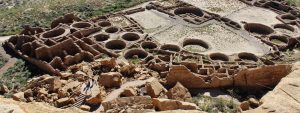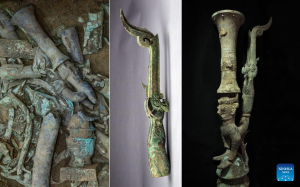Recent class discussions about the Native American city of Cahokia, including the different political, social, economic and physical conditions which allowed it to both thrive and fall as described by Timothy Pauketat, have highlighted exactly how advanced Native American societies were pre-contact with Europeans. Another example of early but advanced systems in the Americas, active in roughly the same period as Cahokia, is a 1,400 year old Native American canal in Alabama.

Figure 1. Harry King, a local who encouraged archaeological study of the “Indian Ditch,” near a trench dug to study the canal. Photograph by Gregory Waselkov, retrieved through Smithsonian Magazine.
This canal, nearly a mile long, is located in Gulf Shores, Alabama, in between bodies of water Oyster Bay and Little Lagoon. While some have acknowledged it as a likely pre-white settler build since the 1820s, it has lacked academic research entirely since, and some anthropologists like Gregory Waselkov believed it was a structure from the nineteenth century, such as a ditch produced through slave labor (Gannon 2022). Local resident Harry King (Figure 1), however, encouraged archaeologists to investigate the site, which locals called “Indian Ditch,” in 2017 (Powell 2022).
In their two cross section diggings, the excavation team found charcoal samples on a surviving berm, or ledge, of the canal (Powell 2022). They were then able to radiocarbon-date these samples, which displayed that “the construction [occurred] between 576 and 650 C.E., at the end of the Middle Woodland period” (Gannon 2022). Gannon goes on to state that a small village from that time called Plash Island, located nearby one end of the canal, was likely responsible for its construction. By using this canal, they would have been able to access better areas for fishing, as well as cooking and preserving the fish, which would have been “crucial” as they did not use agriculture in this area during the time period (Gannon 2022).
In addition to allowing easier access of bodies of water for fishing, curator William Marquardt states that the canal would have acted as “basically the front door to the Southeast,” as this was a time of significant travel and trade in eastern North America (Gannon 2022). Gannon’s article discusses how due to its location between the Gulf of Mexico and Mobile Bay, the canal would have been vital for goods to enter Mobile Bay from the Gulf or Florida and then disperse through several different pathways from Mobile Bay. Gannon also discusses how this canal may bring more evidence subverting the previous theories of hierarchical societies being needed to create these waterworks during the Middle Woodland period, as this society seemed relatively egalitarian.

Figure 2. A 2018 image of the canal’s south end, showing where it connects with Little Lagoon. Photograph by Gregory Waselkov, retrieved through Smithsonian Magazine.
It is noted that there is still much research to be done not only on the hydrological engineering that made this canal possible, but also the “possible spiritual and symbolic dimensions of the waterway” (Powell 2022) that could give more insight on how Middle Woodland period societies in this area functioned and interacted with each other. However, despite the seemingly small span of this site, the research done on it has clearly already changed how anthropologists view the people living further southeast from Cahokia, as well as further proved just how advanced Native American engineering was.
Further Reading
The Middle Woodland Period – NPS Fort Smith
Ancient Canal Systems in the Americas – Ancient Wisdom
References
Gannon, Megan. 2022. “Archaeologists Dig Up 1,400-Year-Old Native American Canal in Alabama.” Smithsonian Magazine, October 6. (Retrieved from https://www.smithsonianmag.com/science-nature/archaeologists-dig-up-1400-year-old-native-american-canal-in-alabama-180980742/).
Powell, Eric. 2022. “Opening the Alabama Canal.” Archaeology Magazine, November/December. (Retrieved from https://www.archaeology.org/issues/489-2211/digs/10896-digs-alabama-canal).



















